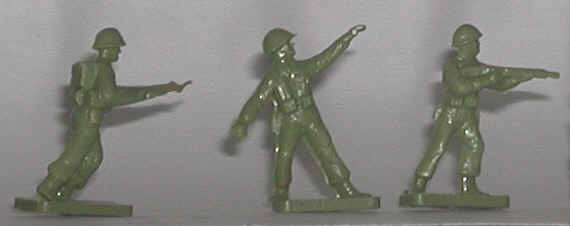
Charging, Grenade thrower, firing "Sten" submachine gun
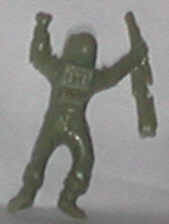
Crawling guy

Kneeling firing rifle, casualty, radioman and officer

Walking with jerry can

Stretcher bearers
Copyright 2012 T. Sheil & A. Sheil All Rights Reserved
Airfix
HO / OO Miniature Soldiers
The hobby shop that opened in our neighborhood stocked two of the most thrilling products: ROCO Minitanks and Airfix soldiers. The initial offerings seemed paltry even five years later, but back in 1961 they were amazing. Unlike the usual bags of army men we accumulated, the Roco tanks and Airfix soldiers were tiny. The soldiers came in a small box with a cellophane window on front and simple printing. I remember the first two sets: Infantry Combat Group and German Infantry. Their other sets did not interest us because they were for HO trains. We were a Lionel train family and that meant the larger O gauge. The Airfix Civilians, Farm animals, Color Guard Party and Marching Band were uninteresting at best.
Those first soldier sets were amazing. They each had 48 pieces in a great assortment of poses. There were stretcher bearers, machine gun shooters, charging guys, crawling guys, standing and kneeling riflemen and grenade throwers. The Germans also came with bazooka men and an antitank gun with its gunner and loader. Each set also had an officer. For a dollar, we could buy one box of soldiers and two Minitanks.
The hobby shop made a diorama using Airfix soldiers, Minitanks and HO scenery. It was a battle in a town, probably i nan area of 12 by 18 inches. Someone had painted the belts, boots, weapons, hand and faces of the soldiers. They were in houses, on miniature streets and fighting over a small bridge. A few vehicles also squared off. That diorama made quite an impression and helped sell many sets of soldiers and tanks.
Airfix expanded in wild ways. On the heels of the first two sets came the Afrika Korps, British 8th Army, US Marines, French Foreign Legion, Cowboys, Indians, Civil War Guys and artillery. Instead of battles that took up the entire living room, we could have huge battles on a table top.
The Airfix sets of the first few years were crude by today's standards. The hands and faces were almost formless and the poses were a bit stiff. Details were thick. They were close to HO, being more of an OO 1/76 scale. Later figures would be slightly larger.
It is hard to find the original series of Airfix sets today. The company replaced most of them with updated sets that had better detail and more animated poses. The Civil War sets, Cowboys, Indians and Wagon Train were not updated.
Infantry Combat Group
Our first set of Airfix soldiers was the Infantry combat group. There were 48 soldiers who came in 11 poses. Cast in a medium olive drab color, we took them for US troops. Actually, they were British with a few anomalies. The Infantry Combat Group wore the late-war British "Turtle shell" helmet. Their field gear featured short ammo pouches rather than the longer ones on British field gear. The poses were very much like the Herald Khaki Infantry, which were popular at the time. There were 7 combat poes: kneeling and standing firing, grenade thrower, crawling rifleman, officer, soldier getting shot and soldier charging with bayonet. The 4 other poses were a kneeling radioman, soldier walking with "Jerry can", stretcher bearer and casualty on stretcher. The set included no soldiers with heavy weapons.
Charging, Grenade thrower, firing "Sten" submachine gun |
Crawling guy |
Kneeling firing rifle, casualty, radioman and officer |  Walking with jerry can |
 Stretcher bearers |
German Infantry
The Airfix German Infantry were molded in a blue-grey color. They included a larger variety of poses that the Infantry Combat Group and had several heavy infantry weapons. When it came to firepower, Airfix's Germans had the edge. Along with several riflemen were men with panzerfausts, panzershrecks (German bazookas), a flamethower and a light antitank weapon with a very loose resemblance to the German 28/.20 antitank gun. The only thing missing was any sort of machine gun. The panzerfausts, panzerschrecks, flamethrower, submachine gun and antitank gun were probably sculpted by someone who had never seen one up close. Airfix was busy making interesting toy soldiers. They had not grasped the concept of a balanced representation of a small infantry force.
The Germans looked good. They had some intriguing poses and a better assortment of weapons than the Infantry Combat Group.
We did not paint the troops shown here. They were already painted when we acquired them.
 |
|
 | 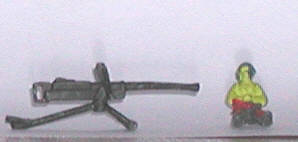 |
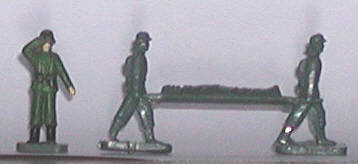 | 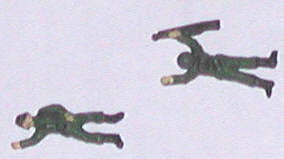 |
US Marines
By the time we figured out that the Infantry Combat Group were British and not American, Airfix issued the US Marines. This was a set that had many great poses, even though the sculpting was still crude. Airfix had yet to upgrade its sculpting in 1963, when the US Marines set arrived. There were standing and kneeling firing riflemen, a crawling guy, grenade thrower, charging guys, running guys, flamethrowers, a raft with two oarsmen, and a bazooka team. Two figures held what looked like M16 rifles, which did not appear in the US arsenal in until the 1960s.. The Marines were excellent for representing American infantry. The only missing element was any kind of machine gun or automatic rifle.
We liked the Airfix marines. The poses had better animation that their other sets at the time (Infantry Combat Group, German Infantry, Afrika Korps and 8th Army). They were good for beach landings or house to house fighting. Crude as they were, their equipment was more accurate than the Infantry Combat Group and it was appropriate for US forces.
Aurora copied most of the Airfix Marine poses for its Anzio Beach Set.
Riflemen. 2nd from Left looks like he has an M16. |
Riflemen. Troops posed like the first soldier were in several sets. |
Riflemen and bazooka man |
Grenade thrower, officer, flamethrower, running man |
From top: casualty, lying figure, crawling rifleman | We are missing the bazooka loader, raft and oarsmen |
Afrika Korps
The initial set of Afrika Korps was a varied assortment of poses and equipment. It arrived in 1962. Coming with the same odd anti-tank gun of the German Infantry, the set also included riflemen in various poses, soldiers digging with shoverl and pick ,and a prone machine-gunner wit ha very crude MG34. Leading this was an officer who looked more like Herman Goering than Rommel, and an officer in shorts and field cap firng a pistol.
 |
|
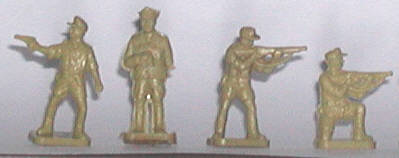 |
The same gun as in the German Infantry set. |
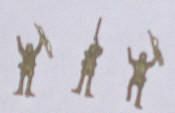 |
8th Army
The arrival of the 8th Army in 1962 brought a larger assortment of poses. There was also a Vickers machine-gun team with prone loader and kneeling gunner. At the time, this set was a big thing. Coming at the same time as Airfix's Afrika Korps, it added a whole new dimension to the hobby. Prior to them, there had been nothing in small scale for the North African theater. A few years later the "Rat Patrol" would make its debut on TV and increase the appeal of these figures. Newer versions of the 8th Army and Afrika Korps were issued in the 1970s.
3rd man is supposed to be firing a submachine gun. | |
Vickers machine gun. grenadier, riflemen and minesweeper | |
Left ot right., from top: Binoculars, rifleman, officer. Bren gun, Vickers loader, rifleman |
British Commandos
This set first arrived in 1968 and it was very well-received. These were an improvement on the old style of sculpting. The poses looked cool, too. At the same time, "Attack on the Iron Coast", a movie with Lloyd Bridges, was in theaters. The story was based on the Saint Nazaire raid. (Seeing the movie years later, and having had military experience by then, the movie looked very hokey. It was a low budget yarn.)
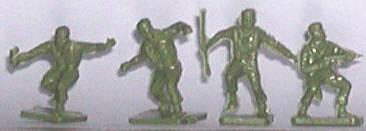 | 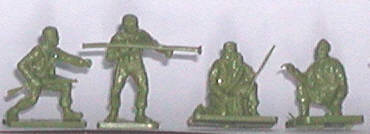 |
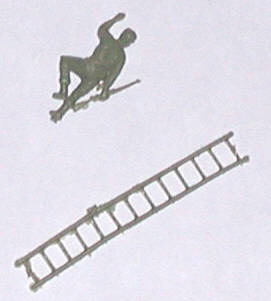 | 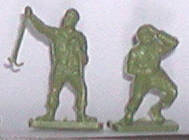 |
Airfix 2nd Series US Marines
The new Marines were issued later in the 1970s. They are distinctly World War II figures and have greater detail. There are fewer poses than the original set. One thing they got right was the inclusion of a machine gunner, in this case a prone figure with the air-cooled M1919 Browning .30 caliber machine gun on a bipod. This set does not have an officer or flamethrower guy.
 | 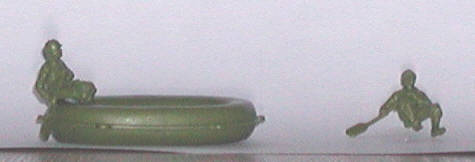 |
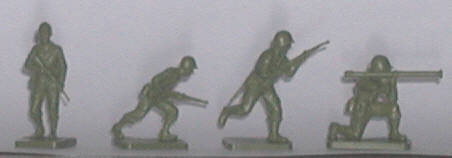 | 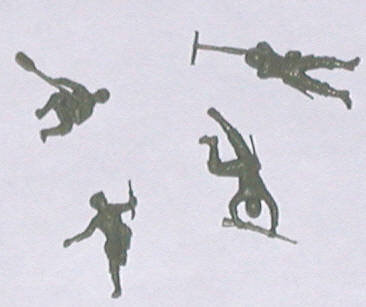 |
Airfix 2nd British Infantry
I still refer to these are the "new" version even though they were issued in 1973. My friends and I had been using the First Series figures for twelve years at the time. The newer figures are easily identified as World War II British. They wear the trench helmet and carry the weapons of the day. Having the prone guy on a base seems silly. Airfix's new British Infantry may have had more detail and realistic equipment, but they lacked something that made the earlier set appealing.
 |
 |
Click here to return to the main page